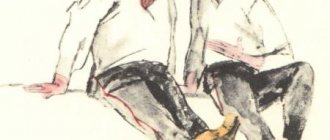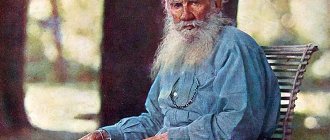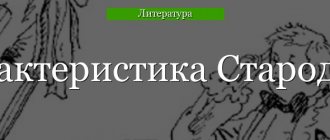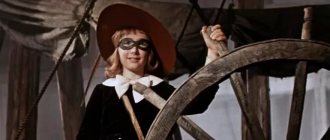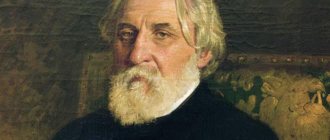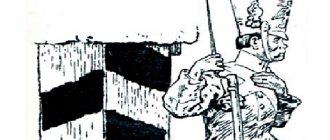Character history
Cultural and artistic figures react sharply to social and political changes in their home countries. The work of Russian writers of the 19th century illuminated the problem that arose in the Caucasus. The war that lasted in this region from 1817 to 1864 did not allow the country to heal from many painful issues. The region attracted poets and writers with its picturesqueness and exoticism, and the local population, with its mentality and morals, seemed rebellious and freedom-loving. Lev Nikolaevich Tolstoy wrote the story “Prisoner of the Caucasus”, inspired by the events that took place in the Caucasus.
"Prisoner of the Caucasus" main characters
The dangerous events that happened to Lev Nikolaevich Tolstoy formed the basis for writing the story “Prisoner of the Caucasus.” During his stay in the Caucasus, the great writer fell into a trap among the mountaineers. There he ended up with his friend, but they managed to avoid a sad fate. They returned home safe and sound. This incident directly affected this work. In "Prisoner of the Caucasus" the plot develops around two officers. Each of them is the complete opposite of the other. The writer compares the characters of the characters, making it clear that if you don’t sit with your hands folded, everything will work out.
History of creation
Writer Leo Tolstoy
This work of Tolstoy stands on a par with the novels “Anna Karenina” and “War and Peace”, which received worldwide recognition. In the 1870s, the writer renounced his past works and began to work on the development of neo-Christian teachings. He lived by the rules he created for himself and created in accordance with his changed worldview. Simplicity in life and creativity became his main focus.
Tolstoy wrote two books: “The ABC” and “The New ABC”. The main difference from earlier works was the clarity of the language and accessibility to everyone who picked up the publications. This is how the writer conveyed his thoughts to the common people. The story “Prisoner of the Caucasus” was included in the first book. The work is based on the personal impressions of Tolstoy, who was almost captured by the Caucasian highlanders in 1853.
The story was published by Zarya magazine in 1872. The author himself considered this work a work of art on a global scale, accessible to people of all backgrounds.
Popular writings
- Taras Bulba - a character born of time - essay (7th grade)
Taras Bulba is a Cossack with a strong, strong-willed character, the hero of the story of the same name by N.V. Gogol. This is a man for whom the main thing in life is freedom, he cannot live peacefully in the kuren, the Cossack longs for military feats. - Essay Conflicts in the play Woe from Wit
In accordance with literary traditions, the comedy belongs to the first Russian realistic play, since the main deviation from classicism is the author’s refusal of unity - Description essay based on the painting Relaxation after the battle by Neprintsev (8th, 9th grade)
Yuri Mikhailovich became eager to create this work of art after reading the work of the famous author. The painter was inspired by a work called “Vasily Terkin”
"Prisoner of the Caucasus"
Zhilin
Russian officer Zhilin, the main character of the work, serves in the troops involved in annexing the Caucasus to the Russian Empire. He comes from a simple family who achieves everything in life on his own. This is how the character attracts the sympathy of readers. Having been captured by the mountaineers, the man demonstrates his ingenuity and fortitude. He plans to escape. The strength of character of the captive evokes respect even among the Tatars who captured him.
Zhilin turns out to be a jack of all trades. He makes a doll for Dina and fixes broken things. At the same time, he behaves boldly and does not humiliate himself. His skills helped the hero hold out in captivity: Dina brought him food, and the Tatars did not punish him. Having received permission to write a letter asking for ransom, Zhilin immediately declares that he will not ask for three thousand coins and is ready to offer only five hundred.
Tatars watch Zhilin's work
The hero is imprisoned in the company of another Russian soldier, Kostylin. The latter values his life much more highly and is ready to ask his relatives for five thousand coins just to get out. He does nothing to get out of captivity, only complains about fate. While Zhilin is digging a tunnel to escape, Kostylin cries while waiting for the ransom.
The prisoners' escape failed because of Kostylin. The Tatars caught the heroes when freedom was very close. The officers had to return to captivity and again think over an escape plan. Instead of a barn, they were placed in a deep ditch. Zhilin was helped to escape by young Dina, who remembered her friend’s kindness. The hero was saved by the Cossacks, and he continued his service. Kostylin was saved thanks to the ransom.
"Prisoner of the Caucasus". Lermontov
Throughout his, unfortunately, short life, he felt a reverent love for the Caucasus and M. Yu. Lermontov. In 1825 he visited this fabulously beautiful region. It greatly excited his imagination and subsequently took a central place in his work. He received all the information about the Caucasus from his relatives living in Mineralnye Vody. In addition, Pushkin’s “prisoner” made an indelible impression on him. Therefore, already at the age of 14 (1818), Mikhail Yuryevich began to write his “Prisoner of the Caucasus.” The plots have a strong similarity and tell how a Russian serviceman is captured by the Circassians. A Circassian woman fell in love with him very much, who later helped him escape. Only Lermontov gave this plot his own unique and inimitable facet.
Source
Comparative characteristics of Zhilin and Kostylin
Illustration for Tolstoy’s work “Prisoner of the Caucasus”
The main idea of Tolstoy’s work is that you should not lose heart and give up when faced with difficulties. Overcoming difficulties requires self-confidence and great desire. This idea can be translated to any situation.
Thinking about which of the heroes had a better chance of being saved, it is logical to assume that Kostylin, who was awaiting ransom, would have been more likely to be free. But Zhilin’s courage and willpower proved the opposite. He does not ask for pity, does not beg for mercy, but acts based on the circumstances. Closeness to the people, honor and decency, nobility and simplicity help Zhilin to stay alive in difficult circumstances.
Both prisoners sat in the barn, chained in stocks, but Zhilin fell in love with the local population. Skilled and dexterous, he quickly found a common language with Abdul-Murat’s daughter. The man made toys for Dina. On walks, he thought of possible escape plans, and at night he dug a tunnel. Lamb and flatbreads brought by the grateful Dina helped him and Kostylin stay alive.
Kostylin writes a letter home
Zhilin and Kostylin are contrasted with each other throughout the entire narrative. Men are in the same position, fighting for the unification of the Caucasus and Russia. They were captured on the way home, and Zhilin was going to see his mother, who was on her deathbed. The Tatars noticed the Russians and captured them. The brave Zhilin constantly found himself in disastrous situations because of the cowardly and narrow-minded Kostylin. The savvy hero found an approach to the Muslims, did not pay the ransom and won over the eastern people. Kostylin feared for his life and did everything he was told.
The biographies of the captives are different, so the characteristics of their images demonstrate the contrast of qualities, talents and skills. Zhilin was persistent, firmly believed in success, spared no effort to achieve what he wanted, and made efforts in any business he took on. Kostylin was idle waiting for help, taking a passive position, knowing that he would be helped out of compassion.
Still from the film “Prisoner of the Caucasus” (1975)
Kostylin was not known for his endurance. His vices made themselves known during his first escape. He was a burden for Zhilin. The second escape became an impossible test for him, and Kostylin preferred to wait for the final with folded arms.
It was not without reason that Tolstoy called the story “Prisoner of the Caucasus”, meaning one hero, although it was about two characters. For the author and readers, the real hero of the story turned out to be one person. Passive Kostylin was a pathetic character who got in the way of Zhilin, who independently created his own destiny. The names of the characters accurately describe their characters and appearance. Zhilin and Kostylin are representatives of completely different personality types, so their destinies are different and their life paths diverge.
Detailed characteristics
Zhilin is the main character of Leo Tolstoy’s story “Prisoner of the Caucasus”, a Russian officer participating in the war for the annexation of the Caucasus to Russia. Zhilin is not from a rich family, he is used to achieving everything himself. By his human qualities, he evokes only sympathy among readers. Having been captured by the Tatars, he does not become limp, but thinks about how to return back to the detachment. Over time, even the harsh Tatars warmed to him. After all, he could make a clay doll for Dina and fix broken objects. He behaved boldly and confidently in captivity. When the Tatars suggested that he write a letter to his mother asking for a ransom of three thousand coins, he immediately refused and said that he could only ask for a ransom of five hundred coins. For this, one Tatar called him a “dzhigit.”
Throughout the entire story, he is contrasted with another Russian soldier, who was also captured with him - Kostylin. He, unlike Zhilin, is ready to ask for a ransom for himself, as much as five thousand coins, and to betray his friend. During his time in captivity, all he does is whine and complain. While Zhilin is contemplating an escape plan and digging in the barn, Kostylin is still waiting for the ransom to arrive.
For his courageous character and skillful hands, many Tatars in the village began to respect Zhilin. And the little girl Dina became so attached to him that she began to regularly bring milk, cakes, and sometimes meat. For this, Zhilin made clay dolls for her.
Even the yard dog loved Zhilin because he sometimes fed it. When the time came to run, he threw her a flatbread, and she and Kostylin were able to get out of the village unnoticed. However, the escape was not successful the first time, since Kostylin whined all the way and fell behind. They were noticed by one Tatar, and they were captured again. This time they were put not in a barn, but in a deep ditch. Dina came to Zhilin’s aid. She brought a long stick with which he climbed out of the hole and was able to escape. Having overcome all obstacles, Zhilin was rescued by Russian Cossacks and remained to serve in the Caucasus. But Kostylin still waited for the ransom and was released, albeit barely alive.
Film adaptations
The story by Lev Nikolayevich Tolstoy was first filmed in 1975 by director Georgiy Kalatozashvili. Actor Yuri Nazarov played the role of Zhilin in the film.
Yuri Nazarov and Sergei Bodrov Jr. as Zhilin
The second film adaptation was presented in 1996. It is based on the leitmotifs of the work, but the action is transferred to modern realities. Sergei Bodrov Sr. described what happened during the Chechen War, reinforcing Tolstoy’s idea that his idea is relevant regardless of the situation and the proposed circumstances. The role of Zhilin was played by Sergei Bodrov Jr.
